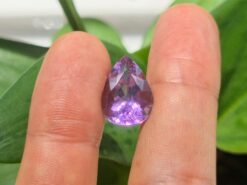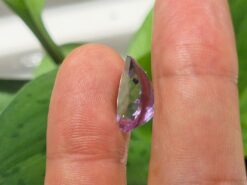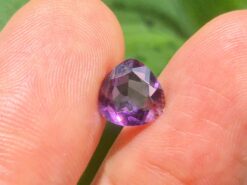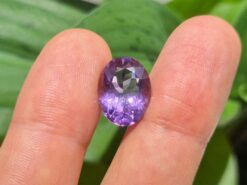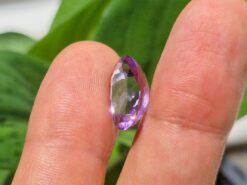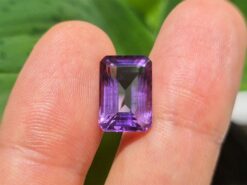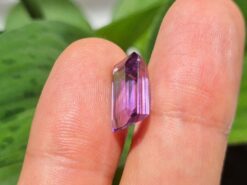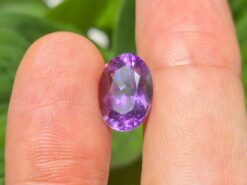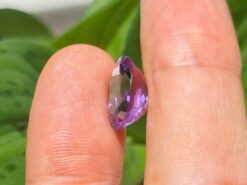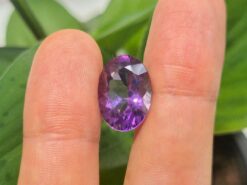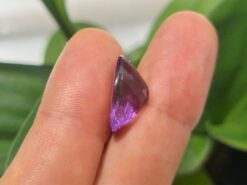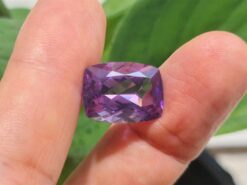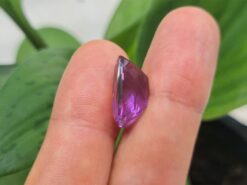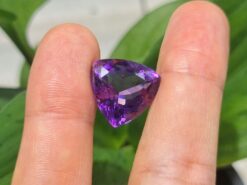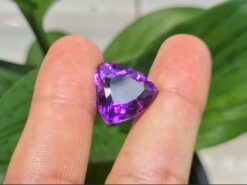Amethyst
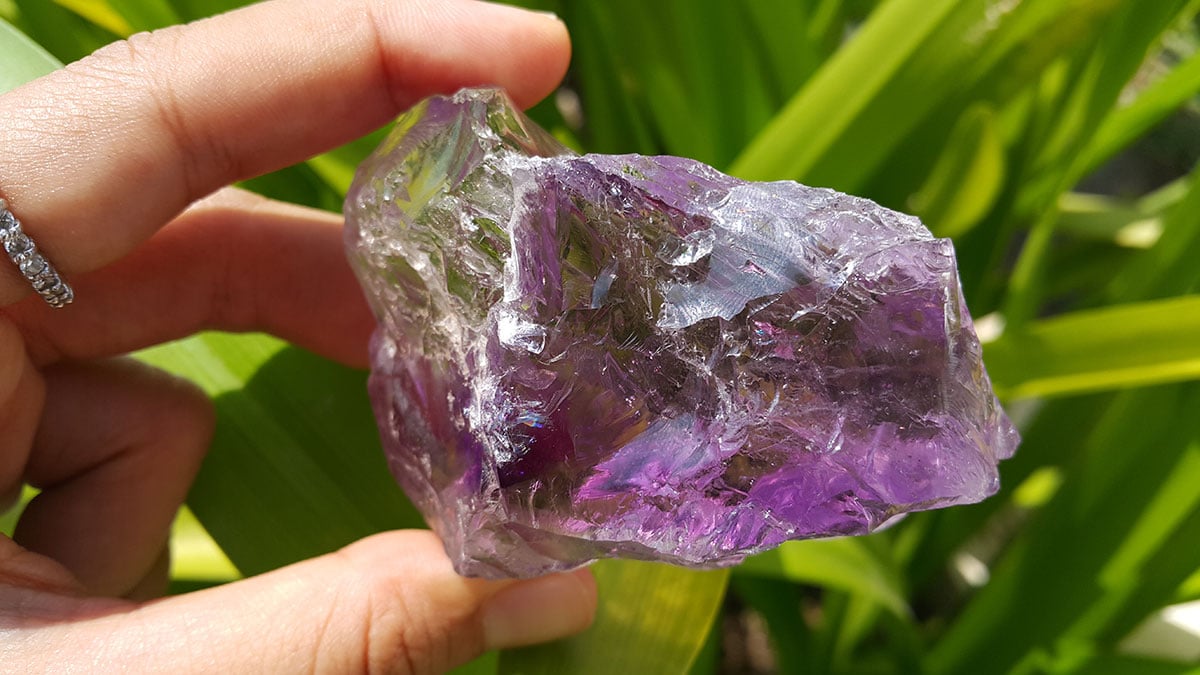
Amethyst crystal stone meaning and properties.
Buy natural amethyst in our shop
Natural amethyst is a purple color variety of crystalline quartz. It owes its purple color due to natural irradiation of iron impurities. In some cases in conjunction with transition element impurities.
The presence of trace elements result in complex crystal lattice substitutions. Also, the hardness of the mineral is the same as quartz. Thus it is suitable for use in jewelry with affordable price.
During the Renaissance, the gemstone has stood for humility and modesty. Throughout the ages, powerful and rich monarchs have used the crystal as a symbol of royalty, and some even decorate the British Crown Jewels.
Rough rom Kampong Thom, Cambodia
Hue
Amethyst gemstone occurs in primary hues. From a light pinkish violet to a deep purple. It may exhibit one or both secondary hues: red and blue. Siberia, also Sri Lanka, Brazil and Asia are the mine sources of the best varieties. Deep siberian is the ideal grade name.
It has a primary purple hue of around 75 – 80%, with 15 – 20% blue. Depends on the light source. Green quartz is also incorrectly called green amethyst. It’s not an appropriate name for the stone. The proper terminology is prasiolite. Other names for green quartz are vermarine or lime citrine.
Tone
The color of natural crystal is often laid out. From stripes parallel to the final faces of the crystal. Also, one aspect in the art of lapidary involves correctly cutting the stone. Color zoning makes the tone of the finished gem homogeneous. Often, only a thin surface layer of violet color is present in the stone. The color is not homogeneous makes for a difficult cutting.
Color of amethyst
The color is the result from substitution by irradiation of trivalent iron (Fe3+) for silicon in the structure. In the presence of trace elements of large ionic radius. Also to a certain extent, the quartz color can naturally result from displacement of transition.
Elements even if the iron concentration is low. Natural stone is dichroic in reddish violet and bluish violet. But heat treated amethyst turns yellow-orange. It can also tunrs to yellow-brown, or dark brownish. It may resemble citrine, but loses its dichroism, unlike genuine citrine.
Dark amethyst price is usually more expensive and consider more desirable than light amethyst.
Gem can fade in tone if overexposed to light sources. It can also be artificially darkened with adequate irradiation.
Rough rom Ratanakiri, Cambodia
Amethyst properties
- Category: Silicate mineral
- Formula: Silica (silicon dioxide, SiO2)
- Crystal system: Trigonal
- Crystal class: Trapezohedra
Identification
- Color: Purple, violet, dark purple
- Crystal habit: 6-sided prism ending in 6-sided pyramid
- Twinning: Dauphine law, Brazil law, and Japan law
- Cleavage: None
- Fracture: Conchoidal
- Mohs scale hardness: 7–lower in impure varieties
- Luster: Vitreous/glassy
- Streak: White
- Diaphaneity: Transparent to translucent
- Specific gravity: 2.65 constant; variable in impure varieties
- Optical properties: Uniaxial (+)
- Refractive index: nω = 1.543–1.553 / nε = 1.552–1.554
- Birefringence: +0.009
- Pleochroism: Weak to moderate purple/reddish purple
- Melting point: 1650±75 °C
- Solubility: Insoluble in common solvents
- Other characteristics: Piezoelectric
Amethyst meaning and healing metaphysical properties benefits
The following section is pseudo scientific and based on cultural beliefs.
Amethyst crystal stone meaning and properties has healing powers to help with physical ailments, emotional issues, in energy healing and chakra balancing.
It is a stone of spiritual protection and purification, cleansing negative energies influences and attachments, and also creating a resonant shield of spiritual light around the body. It acts as a barrier against lower energies, psychic attack, geopathic stress and unhealthy environments.
How wearing amethyst can change your life?
The crystal is on the top of my list for must-have stones! It carries a high frequency that protects the energy field, clears the aura and chakras, and purifies the individual, removing any negative energy and allowing them to move forward in life, into higher states of consciousness.
Birthstone
The semiprecious stone is the traditional birthstone for February.
Amethyst chakra
The crystal works to bring tranquility to your mind and your crown chakra so you can focus on healing any blockages that are holding you back from experiencing bliss. Your seventh chakra is purple and is known as the crown chakra because it’s at the very top of your head.
Legend. The story of amethyste
Amethyste was a young and beautiful woman who was a devotee to the goddess Diana. Diana turned Amethyste into a statue of pure crystalline quartz to protect her from the tigers. Dionysus wept tears of wine in remorse at the sight of the beautiful statue.
The god’s tears stained the quartz purple, creating the gem we know today. Diana is the Roman moon goddess of the hunt and protector of Animals.
One of the most well-known of those protections involves amethyst’s purported power to prevent drunkenness. Another myth about Bacchus, the Roman god of wine, has promoted this belief.
Amethyst zodiac sign
The birthstone for Aries, Aquarius and Pisces signs, known to balance intellect with emotions. The month of February birthstone.
Under microscope
FAQ
What is amethyst used for jewelry?
The crystal is used to produce faceted stones, cabochons, beads, tumbled stones, and many other items for jewelry and ornamental use.The crystal has a Mohs hardness of 7 and does not break by cleavage.
It is a gem that is durable enough for use in engagement rings, necklace, stud earrings, pendants, bracelets and other types of jewelry.
What are the benefits of amethyst?
According to online claims, the stones are said to have several physical healing properties, including:
- enhancing the immune system.
- improving endocrine function.
- improving the skin’s appearance.
- promoting digestive health.
- reducing headaches.
- regulating hormones.
What do amethyst symbolize?
Aside from the crystal stone meaning and properties, It is widely believed to be of great use to those who practise meditation. Its very presence is believed to heal the mind in many cultures around the world, so it has enjoyed incredible popularity with such a broad range of people over the years.
What bad effects does amethyst stone have?
Side effects by likelihood and severity
- Acne.
- Breast pain.
- Dizziness.
- Nausea.
- Swelling of the abdomen.
- Vomiting.
- Water retention.
Is Amethyst rare?
The biggest factor in the value of this stone is the color displayed. The highest-grade gemstone is exceptionally rare and therefore, when one is found, its value is dependent on the demand of collectors. It is, however, still orders of magnitude cheaper than the highest-grade sapphires or rubies.
How can you tell the difference between amethyst and fluorite?
These dark purple or violet crystals are easily confused with quartz, although fluorite’s distinctive crystal shape, four planes of cleavage, and its relative softness can distinguish the two. Fluorite exhibits perfect cleavage in four directions to form octahedrons.
How do I clean amethyst?
It can be safely cleaned with warm soapy water. Ultrasonic cleaners are usually safe except in the rare instances where a stone is dyed or treated by fracture filling. Steam cleaning is not recommended, and It should not be subjected to heat.
What is green amethyst?
Prasiolite, also known as green quartz, green amethyst or vermarine is a green variety of quartz, a silicate mineral chemically silicon dioxide. Most stones will turn yellow or orange when heated producing citrine, but some gems will turn green when treated.
What is the hardness of amethyst?
The stone rates a 7 on the Mohs scale and has good toughness, so it is suitable for all jewelry types. This includes rings and necklace as long as the wearer understands the limits of its hardness.
Is amethyst a precious stone?
It is a semi precious stone. in gemology science, there are only four precious stones : Diamond, ruby, sapphire and emerald.
Natural amethyst for sale in our gem shop
We make custom made amethyst jewelry as engagement rings, necklaces, stud earrings, bracelets, pendants… Please contact us for a quote.

